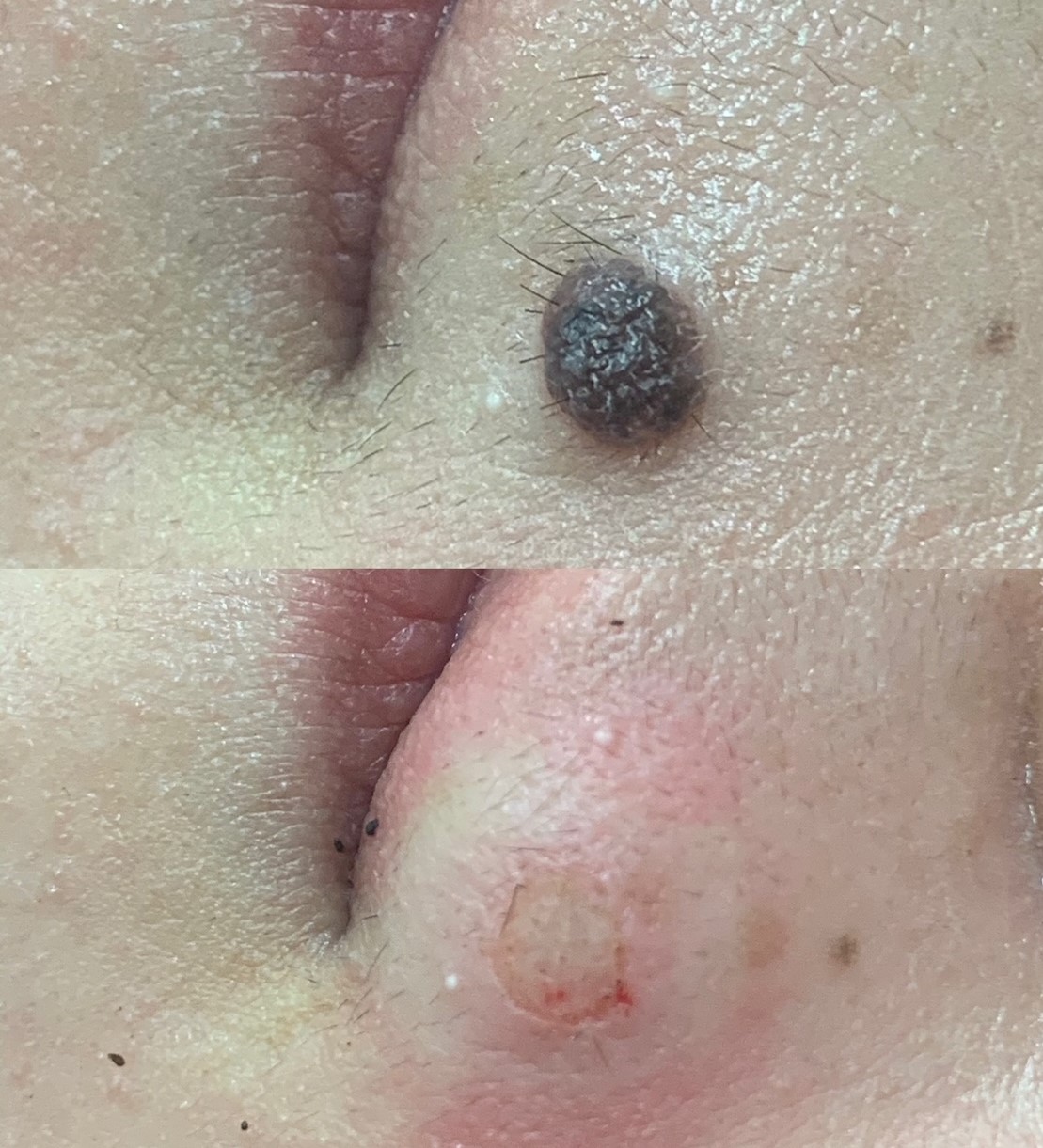 Immediately after surgery, the area will appear red and look like an abrasion. Because the epithelium is missing, a medical dressing will be applied for about a week to allow for early epithelialization. Scars tend to remain (raised, hypertrophic scars) in areas where the skin moves, such as around the eyes, mouth, and lower jaw. The redness will disappear in about 4 months, changing to almost skin color and becoming less noticeable. During these four months, it is necessary to block out as much light as possible. If the affected area is exposed to strong ultraviolet rays, pigmentation may remain for a long time. The first week of care is important. Immediately after removal, a steroid ointment containing antibiotics is applied once. Apply a medical wound dressing over it. This will cover the scar after mole removal and keep it moist, allowing the epithelium to grow. Once epithelial formation occurs, no dressing is required. No disinfection or topical medication is required. As a general rule, hospital visits are not required.
Immediately after surgery, the area will appear red and look like an abrasion. Because the epithelium is missing, a medical dressing will be applied for about a week to allow for early epithelialization. Scars tend to remain (raised, hypertrophic scars) in areas where the skin moves, such as around the eyes, mouth, and lower jaw. The redness will disappear in about 4 months, changing to almost skin color and becoming less noticeable. During these four months, it is necessary to block out as much light as possible. If the affected area is exposed to strong ultraviolet rays, pigmentation may remain for a long time. The first week of care is important. Immediately after removal, a steroid ointment containing antibiotics is applied once. Apply a medical wound dressing over it. This will cover the scar after mole removal and keep it moist, allowing the epithelium to grow. Once epithelial formation occurs, no dressing is required. No disinfection or topical medication is required. As a general rule, hospital visits are not required.

Reading Time: <1 minuteWe receive many inquiries about mole removal every day. In order to remove moles as much as possible, many ablation treatments using carbon dioxide laser or electric vaporization are also performed. If there is even the slightest suspicion of a malignant tumor or if pathological examination is necessary, it is assumed that removal by excision is preferable. However, from a cosmetic point of view, a considerable amount of scarring may remain, which may be more noticeable than a mole. Although mole treatment using carbon dioxide laser is considered to be the most advanced method, I have been using it for 30 years. Since the treatment is performed using a carbon dioxide laser, moles can be removed neatly and there will be no scars left. In many cases, it is better to have a highly skilled specialist carefully remove the stain using electrotranspiration, leaving no scars. Heat is generated before transpiration, so in our hospital we repeatedly cool the affected area with a -20°C cooling device to prevent heat damage to normal tissues. For anesthesia, we use a drug containing xylocaine and meiron, which has a pH adjusted and causes almost no pain during injection. Depends on the location of the mole, the size of the mole, the depth of the pigment on the mole, the condition of the mole, and the treatment after mole removal. You have to consider everything and decide whether it can be removed cleanly.
 Immediately after surgery, the area will appear red and look like an abrasion. Because the epithelium is missing, a medical dressing will be applied for about a week to allow for early epithelialization. Scars tend to remain (raised, hypertrophic scars) in areas where the skin moves, such as around the eyes, mouth, and lower jaw. The redness will disappear in about 4 months, changing to almost skin color and becoming less noticeable. During these four months, it is necessary to block out as much light as possible. If the affected area is exposed to strong ultraviolet rays, pigmentation may remain for a long time. The first week of care is important. Immediately after removal, a steroid ointment containing antibiotics is applied once. Apply a medical wound dressing over it. This will cover the scar after mole removal and keep it moist, allowing the epithelium to grow. Once epithelial formation occurs, no dressing is required. No disinfection or topical medication is required. As a general rule, hospital visits are not required.
Immediately after surgery, the area will appear red and look like an abrasion. Because the epithelium is missing, a medical dressing will be applied for about a week to allow for early epithelialization. Scars tend to remain (raised, hypertrophic scars) in areas where the skin moves, such as around the eyes, mouth, and lower jaw. The redness will disappear in about 4 months, changing to almost skin color and becoming less noticeable. During these four months, it is necessary to block out as much light as possible. If the affected area is exposed to strong ultraviolet rays, pigmentation may remain for a long time. The first week of care is important. Immediately after removal, a steroid ointment containing antibiotics is applied once. Apply a medical wound dressing over it. This will cover the scar after mole removal and keep it moist, allowing the epithelium to grow. Once epithelial formation occurs, no dressing is required. No disinfection or topical medication is required. As a general rule, hospital visits are not required.
 Immediately after surgery, the area will appear red and look like an abrasion. Because the epithelium is missing, a medical dressing will be applied for about a week to allow for early epithelialization. Scars tend to remain (raised, hypertrophic scars) in areas where the skin moves, such as around the eyes, mouth, and lower jaw. The redness will disappear in about 4 months, changing to almost skin color and becoming less noticeable. During these four months, it is necessary to block out as much light as possible. If the affected area is exposed to strong ultraviolet rays, pigmentation may remain for a long time. The first week of care is important. Immediately after removal, a steroid ointment containing antibiotics is applied once. Apply a medical wound dressing over it. This will cover the scar after mole removal and keep it moist, allowing the epithelium to grow. Once epithelial formation occurs, no dressing is required. No disinfection or topical medication is required. As a general rule, hospital visits are not required.
Immediately after surgery, the area will appear red and look like an abrasion. Because the epithelium is missing, a medical dressing will be applied for about a week to allow for early epithelialization. Scars tend to remain (raised, hypertrophic scars) in areas where the skin moves, such as around the eyes, mouth, and lower jaw. The redness will disappear in about 4 months, changing to almost skin color and becoming less noticeable. During these four months, it is necessary to block out as much light as possible. If the affected area is exposed to strong ultraviolet rays, pigmentation may remain for a long time. The first week of care is important. Immediately after removal, a steroid ointment containing antibiotics is applied once. Apply a medical wound dressing over it. This will cover the scar after mole removal and keep it moist, allowing the epithelium to grow. Once epithelial formation occurs, no dressing is required. No disinfection or topical medication is required. As a general rule, hospital visits are not required.




